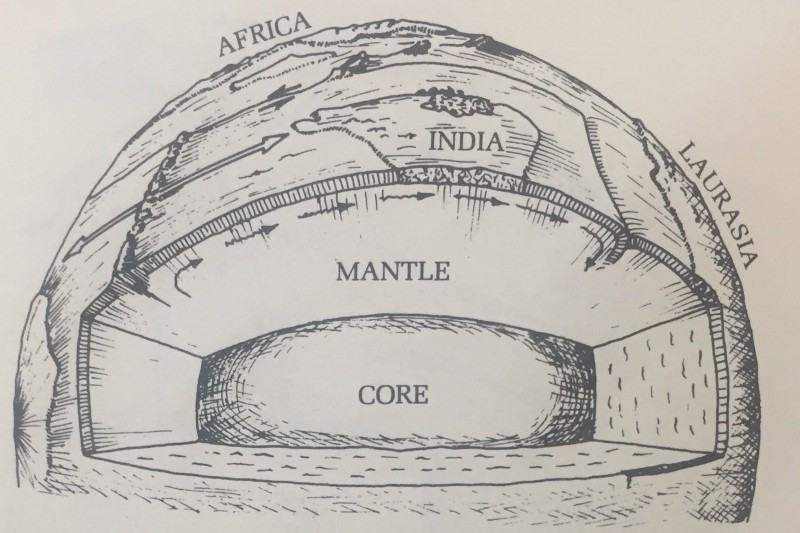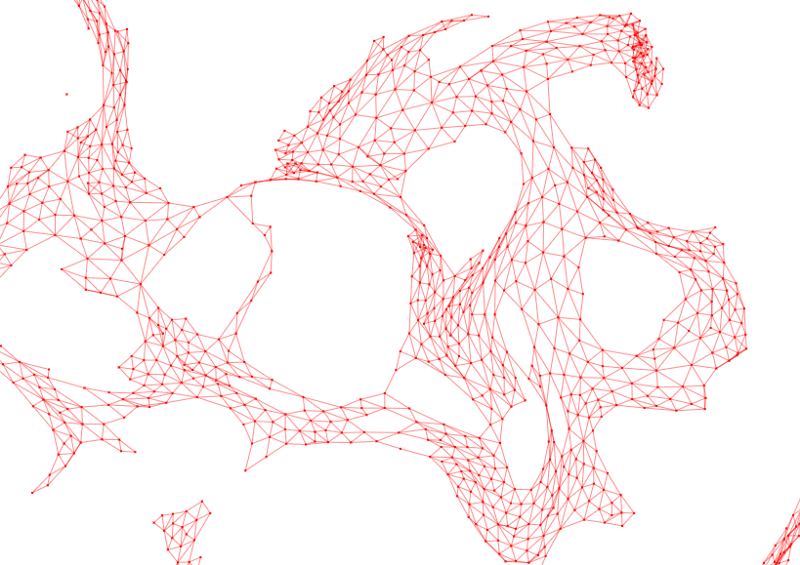I went to the San Francisco Public Library today (which is just across the road from my house — it’s a crime I don’t visit there more often!) to see what I could find in the way of books on plate tectonics. I found Continental Drift and Plate Tectonics by William Glen, published 1975, which had some wonderful diagrams in it.
I learned that there are two broad classes of material that the Earth’s crust tends to be made from: dense basaltic rock which makes up the ocean floor and is about 10 km thick, and lighter granitic rock that makes up continental mass, and is about 25 km thick most places. All the crusty bits are floating on a sort-of-solid goop called the asthenosphere, above which the rock cools down enough to be solid and below which the rock is under so much pressure that it solidifies. So the asthenosphere is kind of like the lubricant that lets the plates slide around.

I tried out a simulation approach for getting bits of crust to float around and bash into each other by scattering points around a slowly shifting vector field, but I’m not particularly happy with the results so far. I added in some more factors like ‘springs’ between bits of crust to get them to stick together and behave a bit more solidly, but the whole thing still really reflects the underlying simplex noise a lot. I think there’s more tweaking to be had here before I move on to a different approach—I haven’t tried to model subduction at all yet, for example — but I’m not especially hopeful.

One really cool thing I learned about from Glen’s book was that Scandinavia is rising up out of the Earth. A few tens of millennia ago, Scandinavia was covered in glaciers and ice sheets. Water is pretty heavy, so all that ice pressed the Scandinavian peninsula down into the asthenosphere, like pushing down on a rubber duck in the bath. All the ice melted, though, so now the whole lot is slowly bobbing back up out of the magma. It’s rising about a centimetre a year, and it’s got about another 150 metres to go. Finland gains 7 square kilometres a year.
The free shop
Cole and I went on a walk around Haight-Ashbury today with Detour, which was excellent and I highly recommend checking out Detour’s other walks (they have a bunch of them, all over the world! … but not in Australia yet.) The tour was a lot deeper and more thoughtful than I was expecting.
As Peter Coyote narrated our ambling through the Haight, he told us about the Diggers, an anarchist improv theatre group of which he was a founding member. I’d heard about the Diggers before, in particular their serving free food in Golden Gate park, but I didn’t know about the free store they ran. It was a garage in the Haight (which we walked past!) and it was a shop where everything was free. That’s it, really. Just a free store.
The anti-capitalist stance of the Diggers turned out not to be sustainable in the heavily capitalist environment of the US, but a lot of their other thinking has solidified into nationwide policy. Coyote attributes the widespread implementation of addiction treatment programs in the present day to the Digger-adjacent Haight Ashbury Free Clinics, founded by David E. Smith, which treated drug addictions in the 60s without a license to do so (since nobody would give them one). The clinic still operates, in the same building it was founded in.